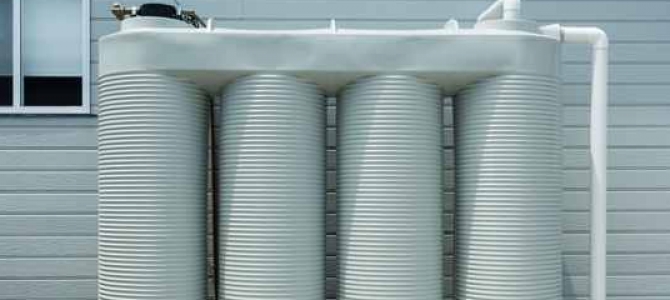 Shopping Cart
Shopping Cart
18 August 2022
How do water tanks work?

Water tanks are a staple fixture in many New Zealand homes. Whilst they have traditionally been found in older homes, built before mains water was available to certain parts of the country, they are making a strong resurgence in light of water shortages and a great focus on the environment and the benefits water tanks bring.
Traditional water tanks are large round structures, either found above the ground on large properties or buried beneath the ground where space is limited. Older water tanks are typically large concrete structures, however, modern water tanks are usually made from polyethylene - a type of plastic that is ideal for water tanks. Stainless steel is another option, but the cost is often prohibitive to many homeowners.
Water tanks were initially used as the only way for households to access clean, running water. Rainwater was collected as it fell on roofs and filtered into the water tank from where it could be accessed from the taps in the house.
Today, however, people are using water tanks as a way of conserving water, cutting down on water bills and contributing to the environment. There is a lot of strain on water supplies in New Zealand, especially in hot, dry summers and recent water restrictions that were put in place in 2020 and 2021 meant that more people started to explore the option of installing a water tank at home.
How do water tanks work?
No matter the size of your water tank or the reason you are collecting rainwater in your tank, they all work in the same way.
A study of water use in Auckland found that, on average, people typically use between 140 and 170 litres of water a day. Whether it’s for drinking, cooking, washing, flushing the toilet, watering the garden, or doing the dishes – water is a resource we all rely on every single day.
In order to service this demand, people are turning to water tanks at their homes and on commercial properties, especially farms and lifestyle properties.
When it comes to collecting rainwater, the process is quite simple. Rainwater is collected from your roof and filtered into your tank until it is required.
Depending on how you plan to use the water will then dictate how the water tank works. On all tanks, there will be a filtration system as the water enters the tank to ensure no insects, birds or animals can find their way into your tank. You can also install gutter screens to prevent debris from washing into your tank that has collected in your gutters.
Many people also install a “first flush diverter” - a simple device that fits onto your downpipe or tank inlet and prevents the initial flow of contaminant-laden water from the roof from entering the tank when it rains.
If you are planning on using the water you collect in your tank for potable uses such as drinking, cooking and washing, then there are other things you need to do.
On top of the measures listed above, you will also need to treat and purify your water. You can do this in a number of ways including adding chlorine, using a very fine filter or purifier, boiling the water or using ultraviolet light treatment (or a combination of these measures).
If you are connecting your water tank to your plumbing system, you are also required by law to ensure that the mains water is isolated from the rainwater system to ensure there is no backflow from your system into the mains supply. You will need a professional plumber to install a backflow prevention device.
You will also typically have a pump on your tank to pump the water you collect into the home or garden. Some tanks that are stored on stilts can use gravity as a way of transferring the water, however, this is not that common in New Zealand and a pump is the preferred method for getting water out of your tank.
Is it worth getting a water tank?
If you are planning a new build, installing a water tank should be one of your primary considerations, especially if you plan on living in the house for a long period of time.
Water tanks, especially those that are plumbed to your property, can save you a significant amount of money, helping to drastically reduce your water bills. Depending on the size of the tank that you install, there is the potential that a tank could supply you with all your water requirements every year. This will also depend on the rainfall and the number of people living in your house, however, it will certainly reduce your costs and pay for itself over time.
You can also take satisfaction in contributing to environmental change. Water tanks help to reduce the strain on stormwater drainage systems, reducing site runoff and flood peaks.
We are seeing more and more extreme weather events in New Zealand and we should be doing everything we can to minimise the impact of these weather events and water tanks are contributing to this change.
Read more about the benefits of water tanks in our recent post.
How do I collect and use rainwater?
We’ve already touched upon how easy it is to collect rainwater from your roof once you have installed a water tank and maintaining your tank is also relatively simple and straightforward.
You will need to carry our regular cleaning of your tanks and the gutters and downpipes that feed your tank, as well as check the quality of the water if you are using it for potable purposes around the home.
You can learn more about how to collect and use rainwater in our beginner’s guide as well as learning how to maintain your tank.
How do I measure the water in my tank?
A lot of people worry about running out of water when they are limited to the rainwater collected in their tank, however, with Smart Water technology, you can see how much water you have in your tank from our smartphone app or desktop or wall-mounted display.
Once installed, our tank sensors and sender will transmit data back to your devices so you can easily find out key information including days to empty, trends, and historical usage that will help you to better plan your water consumption needs.
You can learn more about water tank level indicators in our recent post.
New Zealanders are becoming more proactive when it comes to collecting water in their homes and water tanks are making a resurgence thanks to new, innovative designs and technology like Smart Water’s water tank level indicators that help people to keep on top of their consumption.
You might be surprised about how much rainwater you can harvest from your roof and what this could mean for your water bills.
Find out more about our range of products or check out our FAQs for more information.
Frequently Asked Questions
How do modern water tanks collect and store rainwater?
Modern water tanks collect rainwater primarily from roof surfaces. The water passes through gutter screens and filtration systems to remove debris, insects, and contaminants before entering the tank. Some systems use a “first flush diverter” to prevent initial runoff containing pollutants from entering the tank, ensuring cleaner water storage.
What methods are used to make rainwater safe for potable use?
Rainwater intended for drinking or cooking must be treated to remove harmful microorganisms and impurities. Common methods include chlorination, fine filtration, ultraviolet light treatment, and boiling. Systems must also have backflow prevention devices to isolate the rainwater from mains water and prevent contamination.
How can the water level in a tank be monitored effectively?
Water levels in a tank can be monitored using sensors connected to tank level indicators. These devices provide real-time data on water quantity, trends, and usage history. Data can be accessed via smartphone apps, desktops, or wall-mounted displays, allowing accurate planning of water consumption and efficient management of available resources.
